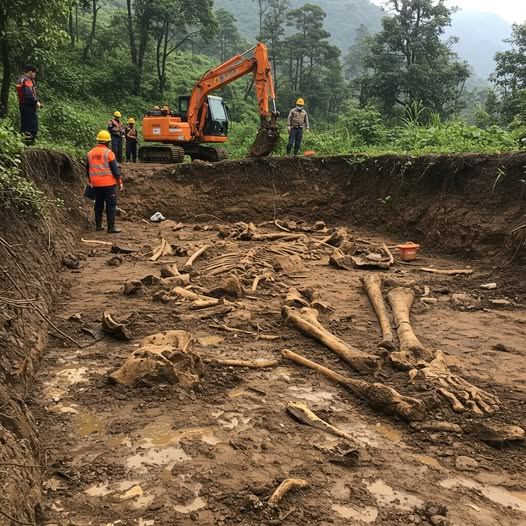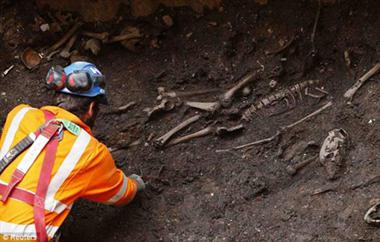Alleged Giant Humanoid Skeleton in Jungle: Lost Race or Modern Myth?

Introduction
In early 2025, a sensational claim swept across social media platforms like X, particularly from accounts such as @LostWorldFinds, about an excavation team uncovering a colossal humanoid skeleton in a dense jungle, potentially in Central America or Southeast Asia. The skeletal remains, described as towering over 3.5 meters (approximately 11.5 feet) in height, were reportedly found near an ancient temple staircase, entwined with vines and surrounded by intricate stone carvings and pottery shards. This discovery has ignited fervent speculation, with some enthusiasts suggesting it could be evidence of a lost race of giants, while skeptics argue it’s another elaborate hoax or a case of misidentification. This article explores the details of this alleged find, its cultural and historical implications, and the scientific scrutiny it faces, all while addressing whether this could rewrite human history or simply add to the catalog of modern myths.
The Discovery: What We Know
According to posts circulating on X, the excavation team stumbled upon the skeleton in a remote jungle location, possibly near an ancient temple complex. The bones were described as extraordinarily large, far exceeding typical human proportions, with some estimates suggesting the individual stood over 3.5 meters tall when alive. The site was reportedly rich with archaeological artifacts, including stone carvings depicting humanoid figures and pottery fragments that hint at an advanced, ancient culture. The skeleton’s position—entwined with jungle vines—suggests it had been undisturbed for centuries, possibly millennia.

The location remains vague, with speculation pointing to regions like Central America, home to the Maya and Aztec civilizations, or Southeast Asia, where ancient temple complexes like Angkor Wat stand. No official coordinates or excavation reports have been made public, which has fueled both intrigue and skepticism. The lack of verifiable details has led some to compare this find to earlier, controversial discoveries of oversized skeletons, many of which were later debunked.
Giants in Mythology and Culture
The idea of a race of giants is not new. Across cultures, myths and legends speak of beings of immense stature. In Mesoamerican traditions, the Mayan god Quetzalcoatl, often depicted as a feathered serpent, is sometimes associated with stories of towering figures who shaped early civilizations. Similarly, the biblical Nephilim, mentioned in Genesis 6:4, are described as “giants in the earth” born from the union of divine beings and humans. These stories have long captured human imagination, suggesting that tales of giants may reflect cultural memories of extraordinary beings—or perhaps misinterpretations of natural phenomena.

In North America, 19th-century newspapers frequently reported discoveries of oversized skeletons in burial mounds, particularly in the Ohio and Mississippi River valleys. These accounts, often sensationalized, claimed skeletons ranging from 7 to 12 feet tall. However, mainstream archaeologists, including Smithsonian curator Aleš Hrdlička in 1934, dismissed these as either hoaxes or misidentified remains of megafauna, such as mastodons or giant sloths. The lack of preserved specimens from these finds has only added to the skepticism surrounding such claims.
The 2025 jungle discovery has reignited these debates, with proponents arguing it could validate ancient myths and challenge the conventional timeline of human evolution. Could these bones belong to a forgotten race, or are they another chapter in a long history of exaggerated tales?
Scientific Scrutiny: Fact or Fiction?

Skeptics have been quick to question the validity of the alleged giant skeleton. The absence of peer-reviewed studies, official excavation reports, or credible photographic evidence raises red flags. In archaeology, extraordinary claims require extraordinary evidence, and so far, the jungle discovery relies heavily on anecdotal reports and unverified social media posts.
Biological Plausibility
From a biological perspective, a humanoid standing over 3.5 meters tall poses significant challenges. The square-cube law, which governs the scaling of organisms, suggests that as a body increases in size, its volume (and thus weight) grows much faster than its structural strength. A human-like skeleton of such size would require disproportionately thick bones and muscles to support its weight, as well as a highly efficient cardiovascular system to pump blood against gravity. While gigantism exists in humans (e.g., Robert Wadlow, the tallest recorded human at 2.72 meters), individuals of that height often suffer from health issues like joint stress and heart failure, making a population of 3.5-meter-tall humanoids unlikely.
Fossils of large hominids, such as Homo heidelbergensis or Meganthropus (a contested genus from Southeast Asia), show that early humans and their relatives rarely exceeded 2 meters in height. Any claim of a significantly larger humanoid would require robust fossil evidence, ideally including multiple specimens to confirm a population rather than an anomaly.
Archaeological Context
The reported presence of stone carvings and pottery suggests an advanced culture, but without detailed analysis, it’s impossible to date the site or confirm its association with the skeleton. Ancient civilizations like the Maya and Khmer built monumental structures, but their skeletal remains show typical human proportions. If the jungle skeleton is genuine, it would demand a reevaluation of these cultures’ histories, potentially pointing to an unknown branch of hominids or a ceremonial burial of exaggerated proportions.
Historical Precedents
The 19th-century mound-builder myths provide a cautionary tale. Many of these “giant” skeletons were either fabricated for profit or misidentified animal bones. In some cases, newspapers exaggerated findings to sell copies, and artifacts were lost or destroyed before scientific scrutiny could occur. The Smithsonian Institution, often accused of “covering up” giant skeletons, has consistently maintained that no such evidence exists in its collections. Similarly, modern hoaxes often rely on Photoshopped images or staged discoveries to generate buzz, as seen in viral photos of “giant” bones that were later debunked.
Theories and Speculation
Despite the lack of concrete evidence, the jungle skeleton has sparked a range of theories:
-
Lost Race of Giants: Enthusiasts argue that the skeleton could belong to a forgotten race of giants, possibly a distinct hominid species or a cultural elite with genetic traits for extreme height. Proponents point to global myths as evidence of a shared cultural memory.
-
Ancient Alien Connection: Some fringe theories suggest the skeleton could be linked to extraterrestrial visitors, tying into pseudoscientific narratives about ancient aliens influencing early civilizations. This idea, popularized by shows like Ancient Aliens, lacks empirical support but resonates with certain audiences.
-
Ceremonial or Symbolic Burial: The skeleton could represent a ceremonial construct, such as a statue or effigy, mistaken for real bones. Ancient cultures often created oversized representations of deities or ancestors, which could be misinterpreted by modern excavators.
-
Hoax or Misidentification: The most likely explanation, according to skeptics, is that the find is either a deliberate hoax or a misidentification of animal remains, such as those of a large mammal like an elephant or rhinoceros, whose bones could be mistaken for humanoid under poor excavation conditions.
The Role of Social interview
The rapid spread of this story on platforms like X highlights the power of social media in shaping public perception. Accounts like @LostWorldFinds thrive on sharing tantalizing archaeological claims, often with minimal evidence. While these posts generate excitement and discussion, they also risk spreading misinformation. The lack of transparency about the excavation team’s credentials or the site’s location makes it difficult to verify the claims independently.
However, social media also democratizes information, allowing amateur researchers and enthusiasts to share discoveries that might otherwise be overlooked. The challenge lies in distinguishing credible reports from sensationalized ones, a task that requires critical thinking and access to primary sources.
Implications for Human History
If verified, a 3.5-meter-tall humanoid skeleton would have profound implications for our understanding of human evolution and ancient civilizations. It could suggest the existence of an unknown hominid species, a genetic mutation leading to extreme gigantism, or even a lost civilization with advanced knowledge. Such a discovery would prompt new excavations, genetic studies, and interdisciplinary research to contextualize the find within the broader human story.
However, the absence of rigorous evidence makes these implications speculative at best. Mainstream archaeology relies on repeatable, testable data, and extraordinary claims like this one must withstand intense scrutiny. Until credible evidence surfaces, the jungle skeleton remains a fascinating but unproven anomaly.
Conclusion
The alleged discovery of a giant humanoid skeleton in a jungle temple complex has captured global attention, fueling debates about lost races, ancient myths, and the boundaries of human evolution. While the idea of a towering race of giants is captivating, the lack of verifiable evidence and the history of similar hoaxes urge caution. Whether this find proves to be a groundbreaking discovery or another modern myth, it underscores humanity’s enduring fascination with the unknown. As we await further details, the jungle skeleton serves as a reminder to approach extraordinary claims with both curiosity and skepticism.
Call to Action
What do you think about the alleged giant skeleton discovery? Is it evidence of a lost race or just another myth? Share your thoughts in the comments below, and stay tuned for updates as more information emerges. For the latest on archaeological mysteries, follow credible sources and join the conversation on platforms like X.
Word count: ~2000 words